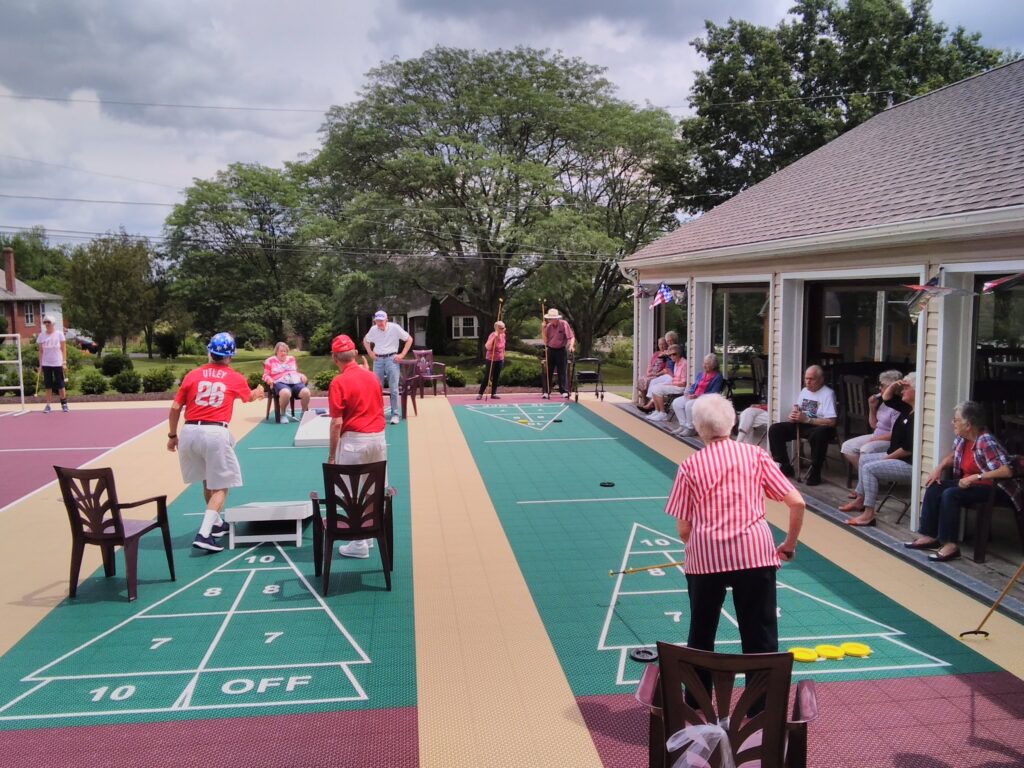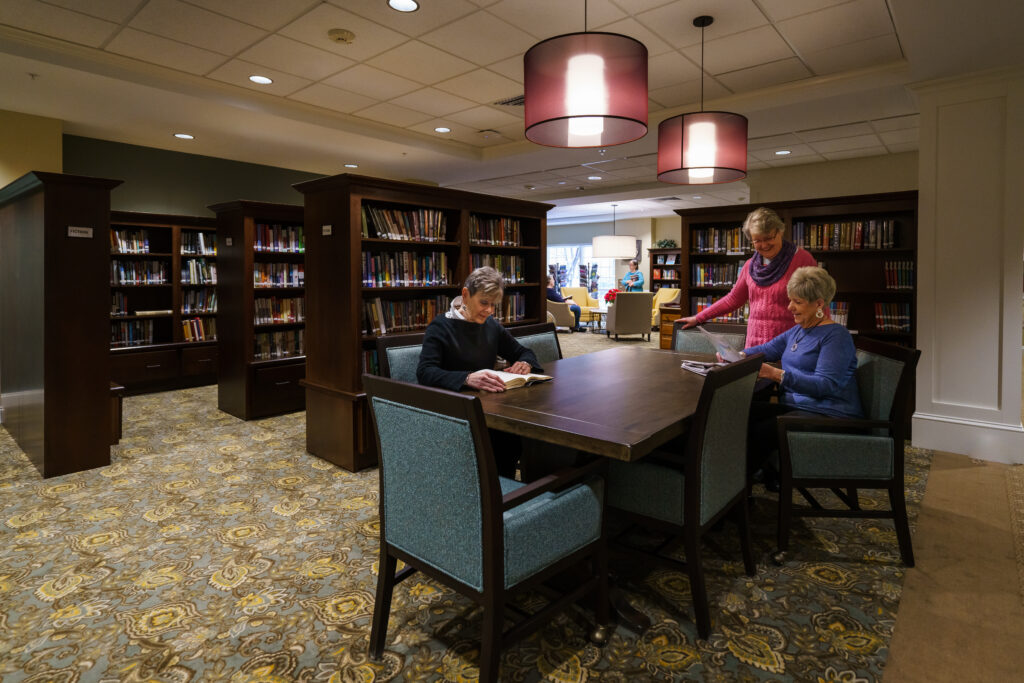While exploring the senior living options for a loved one, you may have encountered the term “Life Plan Community.” This term describes a specific kind of retirement community that you may want to consider as you do more research.
Let’s unpack this term so you can determine whether a Life Plan Community is ideal for you or your loved one.
Put simply, a Life Plan Community offers everything you may ever need – all in one place.
What’s the Difference Between a Life Plan Community and CCRC?
LeadingAge, a nationwide advocacy organization for senior living communities, realized in the 2010s that the name “Continuing Care Retirement Community” (CCRC) does not fully reflect the vibrant lifestyle of today’s senior communities. They coined the term “Life Plan Community” as a new title for a CCRC. In short, there is no meaningful difference between a Life Plan Community and a CCRC – the only difference is the name.

How Do Life Plan Communities Work?
Entrance Fee and Monthly Fees:
- Residents usually pay an upfront entrance fee. Fees vary based on the type of residence and contract.
- In addition to the entrance fee, Life Plan Communities charge a monthly fee to cover housing, amenities, and services like dining, housekeeping, and transportation.
- Depending on your contract type, you may also be paying towards future health care in the community, including memory care or skilled nursing.
Continuum of Care:
- Residents often start in independent living, enjoying an active lifestyle with minimal assistance. They live on their own in a villa, condo, cottage, or apartment, which is typically owned and maintained by the community.
- If health needs evolve, residents can easily transition to assisted living, memory care, or skilled nursing without leaving the community. Residents also have the option of moving into the community at one of these higher levels of care, rather than starting in independent living.
Comprehensive Amenities:
- Most life plan communities offer amenities such as fitness centers, dining options, wellness programs, and social activities that enhance life for residents.
Access All Levels of Care in a Life Plan Community
Life Plan communities offer all three levels of long-term care: independent living, assisted living, and skilled nursing. They may also provide memory care, which can support residents with dementia who need assisted living or skilled nursing care.
Let’s review each level of care that Life Plan Communities offer.
Independent Living
Independent living is exactly what it sounds like: residents live on or near the heart of campus in their own residences, choosing how and when they want to participate in campus life. In a Life Plan Community, residents often start in a villa, condo, cottage, or apartment within the community. Home maintenance is taken care of, and they have access to amenities on their campus, such as restaurants, fitness centers, and other common spaces.
Assisted Living
In assisted living – sometimes called personal care in Pennsylvania – residents live in their own apartment on campus and receive personalized support with some activities of daily living. Caregivers may provide some support with taking medication, using the bathroom, or getting dressed and groomed. Typically, residents in an assisted living community eat together and partake in fitness and recreational activities with their neighbors, enjoying all the amenities their campus center offers.
Skilled nursing
In a skilled nursing neighborhood, residents need the highest level of care. They may have limited mobility, complex health challenges, or chronic illness. Often, these residents receive help with things like eating, hygiene, and moving from a bed to a chair or shower.
Memory care
If the community offers it, a memory care neighborhood provides specialized support for residents with Alzheimer’s disease and other forms of dementia. These communities are designed to be home-like and cozy, offering peace and security within the assisted living or skilled nursing environment. Caregivers in memory care communities are trained to meet the unique needs of a person with dementia and their loved ones.

Amenities and Services in a Life Plan Community
Because they offer the full range of care, Life Plan Communities must meet a range of physical, mental, emotional, and social needs. They are often larger than communities with fewer levels of care, with more resources to provide amenities and services for their residents.
A typical Life Plan Community offers:
- On-campus dining options
- Fitness spaces, including gyms and pools
- Recreation facilities, such as pickleball, bocce, and shuffleboard courts
- Activities, trips, and continuing education opportunities
- Resident-led clubs
- Worship services and small groups for members of various faiths
- Salons and barber shops
- Art and crafting studios
- Libraries and computer labs
- Auditoriums and halls for lectures, concerts, and other large events
- Transportation services for outings and appointments
- Outdoor walking paths, gardens, and seating areas
- Game rooms for activities like cards or board games

What Are The advantages of a Life Plan Community?
There are many reasons to make a Life Plan Community part of your retirement planning. Because they offer all levels of care and numerous services, Life Plan Communities help residents prepare for the future while enjoying the present.
Peace of Mind
From independent living to skilled nursing, there’s a place for every resident in a Life Plan Community. Many residents join at the independent living or assisted living levels, knowing they have the safety net of memory care and skilled nursing. Even better, these resources are already part of their home – there’s no need to move to a new community if the time comes.
Community Atmosphere
Life Plan Communities are not what you may think of as a nursing home. They’re bustling hubs of activity. Residents come and go, doing the jobs, services, and activities they enjoy in the broader community or on campus. And there’s always something to do, whether it’s a social opportunity or an interesting lecture.
Sought-after Amenities
Life Plan Communities are not one-size-fits-all. Providing support for residents at all levels requires a variety of amenities and housing options. Residents at many Life Plan Communities can take advantage of deluxe amenities, such as indoor pools, walking trails, lifelong learning classes, comprehensive wellness programs, and more.

How To Choose The Right Life Plan Community
When it’s time to choose a Life Plan Community for you or a loved one, use this checklist to narrow down your options.
Location
How close is the Life Plan Community to family members, shopping centers, medical facilities, and other important locations?
Housing Options
Decide the housing options you want to consider, including apartments, cottages, and villas. Be sure to consider factors like size, layout, and accessibility.
Payment Structure
Would you prefer to pay a standard fee regardless of the level of care needed, or would you rather pay only for the care needed at any given time? If you pay a standard fee regardless of care level, that’s a Life Care (sometimes called Type A) contract, which requires a higher entrance and monthly fee than a Fee For Service (sometimes called Type C) contract. Fee For Service contracts are known to give residents more flexibility and control over their costs, and Life Care contracts offer stability that appeals to some. Knowing your preferences can help you choose a community that will work for you.
Amenities and Services
Make a list of amenities that are most important to you or your loved one. Consider dining options, recreation, continuing education, wellness programs, clubs and social events, pastoral care, and more. Which amenities are available at the communities you’re considering? How would you rank the quality of your most important amenities?
Non-profit or For-profit
Some Life Plan Communities are non-profit organizations; others are for-profit companies. While both types can offer excellent care and quality of life, there are some key differences:
- Non-profits are driven by a mission to serve their communities, prioritizing the well-being of their residents over profits for shareholders.
- Non-profit organizations may offer financial assistance programs to make their services available to a broader range of people.
- Non-profit organizations often use their resources to invest more intentionally in resident care, team member training, and maintaining or upgrading their facilities.
- Non-profit organizations often have a long history in their communities, making them less susceptible to changes in ownership or management.
- Non-profit organizations may engage in more community outreach and service work. This can give residents and their families a sense of belonging and connection in the wider community.
Resident Testimonials and Visits
Once you have a short list of Life Plan Communities in your area, take some time to tour each one. Bring any questions you may have and ask about connecting with a current resident for their perspective on life in the community. You’ll be given materials to take with you, but you may also want to take notes on your own while you visit.
Choose the level of care that’s right for you at Living Branches, a Life Plan Community. We offer a range of options across our campuses in Hatfield, Souderton, and Lansdale. Contact our sales counselors today to learn more.

